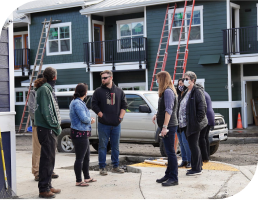We connect and nurture housing system changemakers to do collaborative work that transforms California’s communities into affordable, equitable, and healthy spaces.
We deepen relationships and foster collaboration to address the most pressing challenges facing the California housing system.
Our Regenerative Communities Program supports community leaders as they build a shared understanding around, and take action on, key regenerative development strategies.
We’re excited to reveal our new brand. Our fresh look and updated messaging represent our renewed commitment to building a regenerative California.
We create the conditions to think and work holistically across the housing system — grounding all work in regenerative development practices — so that together we can create a California where all communities are places where people and the environment thrive together.



We believe that big challenges and opportunities can’t be taken on alone. We create spaces where diverse perspectives meet, relationships grow, and ideas that can regeneratively transform communities emerge.
By creating the space to nurture new work through our programs, we help turn innovative concepts into real-world initiatives that benefit communities across California.
By supporting community-driven projects, we spark local transformations that ripple out to larger systems, fostering resilience and systemic change.




Your support fuels our work and allows us to better support regenerative communities throughout California. Help transform the housing ecosystem by donating or become a Founding Sponsor of BIG’s new era.
Sign up for our newsletter to stay up to date about the newest programs events, and resources from BIG and changemakers across California.